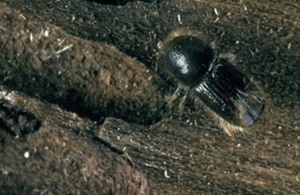Forestry Commission acts on bark beetle tree pest
New breeding populations of the eight-toothed spruce bark beetle (Ips typographus) have been discovered in Kent and East Sussex.

The tree pest eight-toothed spruce bark beetles (Ips typographus)
Woodland managers, land owners, the forest industry and tree nurseries are being urged to remain vigilant after several new breeding populations of the larger eight-toothed European spruce bark beetle (Ips typographus) were identified in Kent and East Sussex.
The UK Chief Plant Health Officer confirmed two breeding populations in two woodlands in Kent on 25 June and 1 July following routine Forestry Commission plant health surveillance activities. Following extensive surveillance, further outbreaks have been found in Kent and East Sussex and the number of outbreak sites is now 13. Swift and robust action continues to be taken in response to the outbreaks, and the Forestry Commission are overseeing the required eradication measures.
Following a finding of the beetle in woodland in Kent in 2018, a demarcated area, enforced by the Plant Health (Ips typographus) (England) Order 2019, remains in place covering parts of the South East of England. Within this area, additional movement restrictions apply on conifer material capable of spreading the pest. Given the recent findings, the boundary of this demarcated area will be extended to help prevent the accidental movement of this pest. A Notice will come into force on 29th October 2021.
Nicola Spence, the UK Chief Plant Health Officer, said:
Several outbreaks of the eight-toothed spruce bark beetle in areas of woodland in Kent and East Sussex have been confirmed. This beetle poses no threat to human health, but can have a serious impact on spruce trees species and the forestry industry.
We are taking swift and robust action to limit the spread of the outbreaks as part of our well-established biosecurity protocol used for tree pests and diseases, and legislation is in place that restricts the movement of spruce trees in the area.
I encourage anyone who suspects a sighting of the bark beetle to report these to the Forestry Commission through the Tree Alert portal.
Enhanced plant health surveillance within the area this year has intercepted a number of bark beetles through the wider environment trapping network, most likely due to natural dispersal of the pest from the continent. As a result, the Forestry Commission and its partners are increasing their surveillance and management activity in the area.
The beetle does not affect human health but can be a serious and destructive pest of the spruce tree species across Europe, although it generally prefers weakened or damaged trees.
Impact on Spruce Christmas Trees
Spruce Christmas trees are considered to be at low risk to Ips typographus as the majority sold will be healthy trees, whereas Ips typographus prefers dying and stressed spruce trees. However precautions have been put in place in the demarcated area around the Ips outbreak sites in South East England for spruce Christmas trees 3 metres in height or more. If you trade in Christmas trees please read the following information.
Moving spruce Christmas trees grown within the demarcated area
Movement of spruce Christmas trees over 3 metres in height must be authorised by a Forestry Commission Plant Health Inspector. The demarcated area has expanded this year, please check the latest map.
The material will be subject to inspection before dispatch and its movement must adhere to conditions set out in an authorisation letter provided by a Forestry Commission Plant Health Inspector. If you grow Christmas trees over 3 metres in the demarcated area, please contact plant.health@forestrycommission.gov.uk.
Moving Christmas trees grown outside of the demarcated area
Outside the demarcated area, you must use a plant passport if you want to move any Christmas trees over 3 metres in height within Great Britain. This relates to spruce and non-spruce varieties and includes foliage taken from conifer trees that is over 3 metres tall.
You need be registered and authorised with the Forestry Commission if you want to use plant passports. For more information, visit the GOV.UK guidance page.
Members of the public can read further information on tree pests and diseases, and how to identify them.
Updates to this page
-
Updated with guidance for Christmas tree sellers.
-
First published.